Customer Lifetime Value and Market Segmentation
VerifiedAdded on 2022/10/19
|8
|2008
|87
AI Summary
This document explains the concept of Customer Lifetime Value and Market Segmentation. It describes the importance of market segmentation and how to calculate customer lifetime value. It also provides examples of companies that have effectively used these concepts and those that have failed due to ineffective implementation. The document includes references for further reading.
Contribute Materials
Your contribution can guide someone’s learning journey. Share your
documents today.
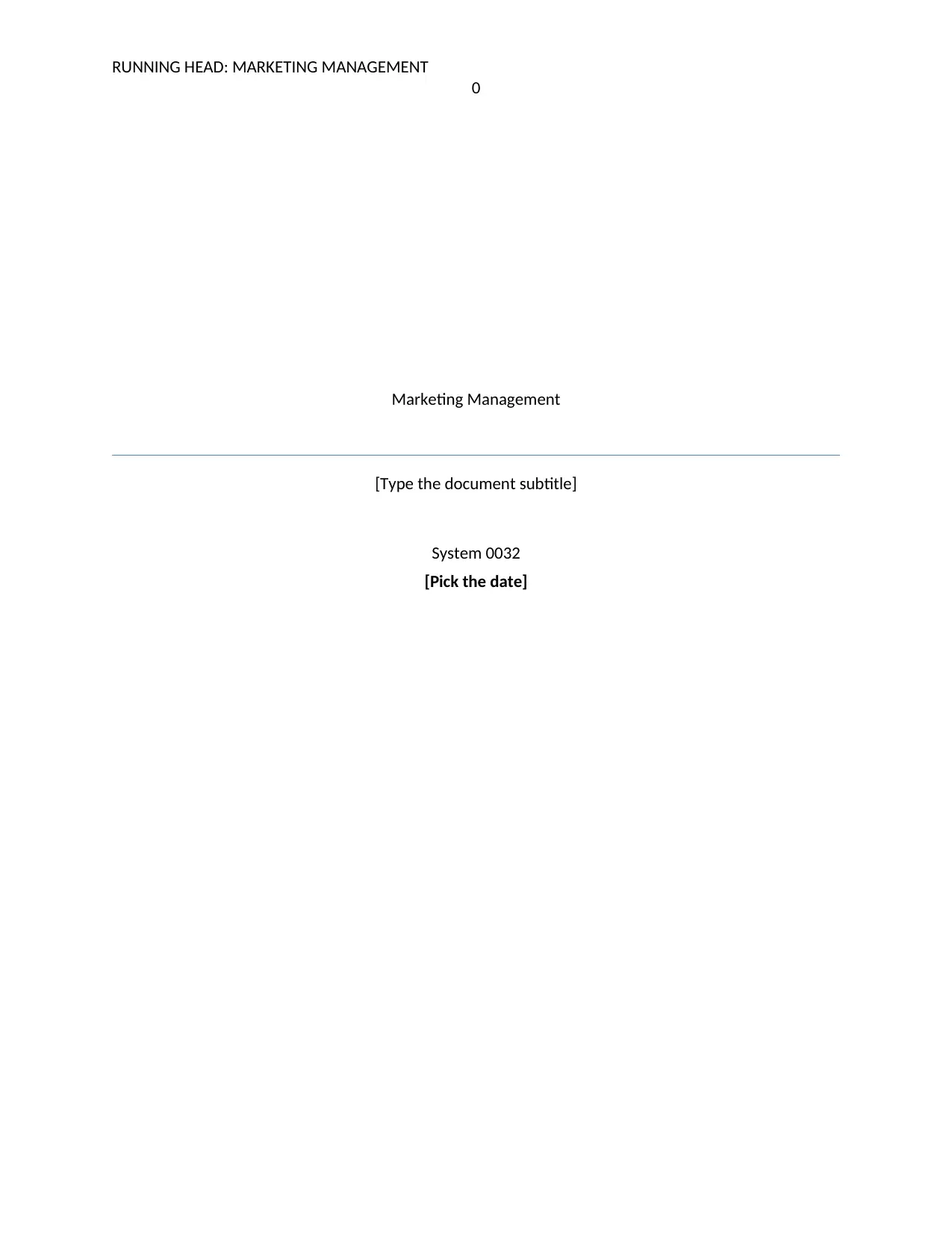
RUNNING HEAD: MARKETING MANAGEMENT
0
Marketing Management
[Type the document subtitle]
System 0032
[Pick the date]
0
Marketing Management
[Type the document subtitle]
System 0032
[Pick the date]
Secure Best Marks with AI Grader
Need help grading? Try our AI Grader for instant feedback on your assignments.
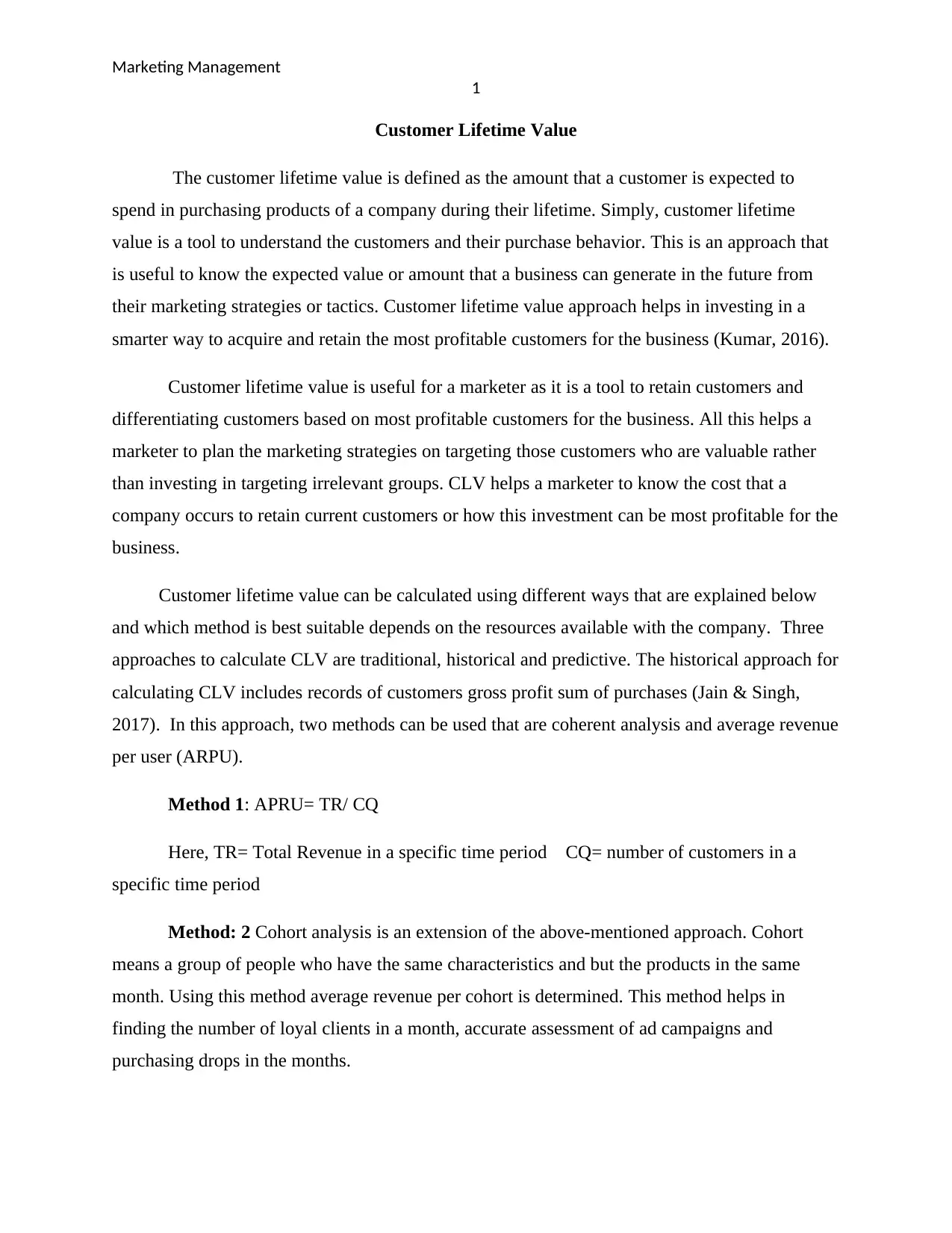
Marketing Management
1
Customer Lifetime Value
The customer lifetime value is defined as the amount that a customer is expected to
spend in purchasing products of a company during their lifetime. Simply, customer lifetime
value is a tool to understand the customers and their purchase behavior. This is an approach that
is useful to know the expected value or amount that a business can generate in the future from
their marketing strategies or tactics. Customer lifetime value approach helps in investing in a
smarter way to acquire and retain the most profitable customers for the business (Kumar, 2016).
Customer lifetime value is useful for a marketer as it is a tool to retain customers and
differentiating customers based on most profitable customers for the business. All this helps a
marketer to plan the marketing strategies on targeting those customers who are valuable rather
than investing in targeting irrelevant groups. CLV helps a marketer to know the cost that a
company occurs to retain current customers or how this investment can be most profitable for the
business.
Customer lifetime value can be calculated using different ways that are explained below
and which method is best suitable depends on the resources available with the company. Three
approaches to calculate CLV are traditional, historical and predictive. The historical approach for
calculating CLV includes records of customers gross profit sum of purchases (Jain & Singh,
2017). In this approach, two methods can be used that are coherent analysis and average revenue
per user (ARPU).
Method 1: APRU= TR/ CQ
Here, TR= Total Revenue in a specific time period CQ= number of customers in a
specific time period
Method: 2 Cohort analysis is an extension of the above-mentioned approach. Cohort
means a group of people who have the same characteristics and but the products in the same
month. Using this method average revenue per cohort is determined. This method helps in
finding the number of loyal clients in a month, accurate assessment of ad campaigns and
purchasing drops in the months.
1
Customer Lifetime Value
The customer lifetime value is defined as the amount that a customer is expected to
spend in purchasing products of a company during their lifetime. Simply, customer lifetime
value is a tool to understand the customers and their purchase behavior. This is an approach that
is useful to know the expected value or amount that a business can generate in the future from
their marketing strategies or tactics. Customer lifetime value approach helps in investing in a
smarter way to acquire and retain the most profitable customers for the business (Kumar, 2016).
Customer lifetime value is useful for a marketer as it is a tool to retain customers and
differentiating customers based on most profitable customers for the business. All this helps a
marketer to plan the marketing strategies on targeting those customers who are valuable rather
than investing in targeting irrelevant groups. CLV helps a marketer to know the cost that a
company occurs to retain current customers or how this investment can be most profitable for the
business.
Customer lifetime value can be calculated using different ways that are explained below
and which method is best suitable depends on the resources available with the company. Three
approaches to calculate CLV are traditional, historical and predictive. The historical approach for
calculating CLV includes records of customers gross profit sum of purchases (Jain & Singh,
2017). In this approach, two methods can be used that are coherent analysis and average revenue
per user (ARPU).
Method 1: APRU= TR/ CQ
Here, TR= Total Revenue in a specific time period CQ= number of customers in a
specific time period
Method: 2 Cohort analysis is an extension of the above-mentioned approach. Cohort
means a group of people who have the same characteristics and but the products in the same
month. Using this method average revenue per cohort is determined. This method helps in
finding the number of loyal clients in a month, accurate assessment of ad campaigns and
purchasing drops in the months.
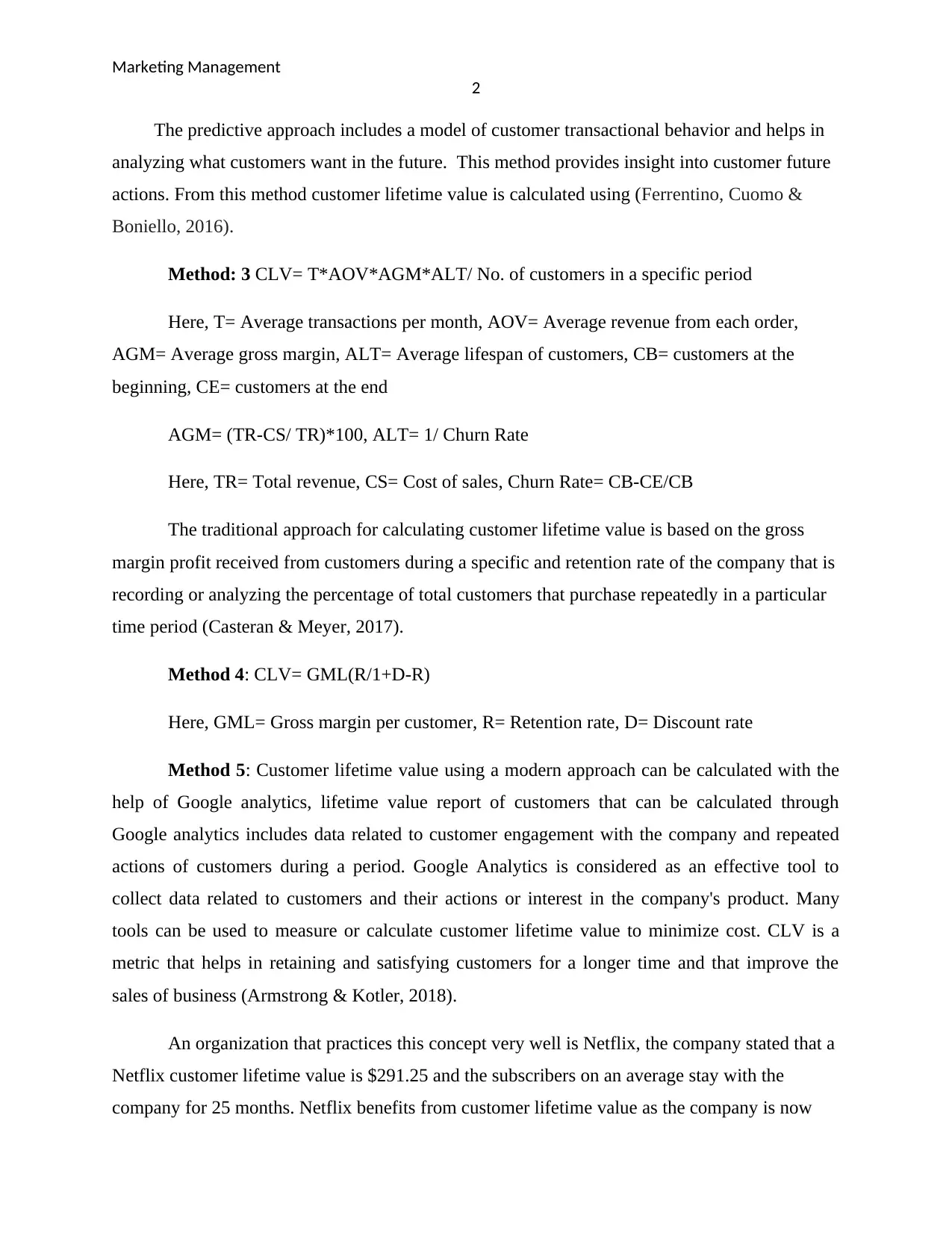
Marketing Management
2
The predictive approach includes a model of customer transactional behavior and helps in
analyzing what customers want in the future. This method provides insight into customer future
actions. From this method customer lifetime value is calculated using (Ferrentino, Cuomo &
Boniello, 2016).
Method: 3 CLV= T*AOV*AGM*ALT/ No. of customers in a specific period
Here, T= Average transactions per month, AOV= Average revenue from each order,
AGM= Average gross margin, ALT= Average lifespan of customers, CB= customers at the
beginning, CE= customers at the end
AGM= (TR-CS/ TR)*100, ALT= 1/ Churn Rate
Here, TR= Total revenue, CS= Cost of sales, Churn Rate= CB-CE/CB
The traditional approach for calculating customer lifetime value is based on the gross
margin profit received from customers during a specific and retention rate of the company that is
recording or analyzing the percentage of total customers that purchase repeatedly in a particular
time period (Casteran & Meyer, 2017).
Method 4: CLV= GML(R/1+D-R)
Here, GML= Gross margin per customer, R= Retention rate, D= Discount rate
Method 5: Customer lifetime value using a modern approach can be calculated with the
help of Google analytics, lifetime value report of customers that can be calculated through
Google analytics includes data related to customer engagement with the company and repeated
actions of customers during a period. Google Analytics is considered as an effective tool to
collect data related to customers and their actions or interest in the company's product. Many
tools can be used to measure or calculate customer lifetime value to minimize cost. CLV is a
metric that helps in retaining and satisfying customers for a longer time and that improve the
sales of business (Armstrong & Kotler, 2018).
An organization that practices this concept very well is Netflix, the company stated that a
Netflix customer lifetime value is $291.25 and the subscribers on an average stay with the
company for 25 months. Netflix benefits from customer lifetime value as the company is now
2
The predictive approach includes a model of customer transactional behavior and helps in
analyzing what customers want in the future. This method provides insight into customer future
actions. From this method customer lifetime value is calculated using (Ferrentino, Cuomo &
Boniello, 2016).
Method: 3 CLV= T*AOV*AGM*ALT/ No. of customers in a specific period
Here, T= Average transactions per month, AOV= Average revenue from each order,
AGM= Average gross margin, ALT= Average lifespan of customers, CB= customers at the
beginning, CE= customers at the end
AGM= (TR-CS/ TR)*100, ALT= 1/ Churn Rate
Here, TR= Total revenue, CS= Cost of sales, Churn Rate= CB-CE/CB
The traditional approach for calculating customer lifetime value is based on the gross
margin profit received from customers during a specific and retention rate of the company that is
recording or analyzing the percentage of total customers that purchase repeatedly in a particular
time period (Casteran & Meyer, 2017).
Method 4: CLV= GML(R/1+D-R)
Here, GML= Gross margin per customer, R= Retention rate, D= Discount rate
Method 5: Customer lifetime value using a modern approach can be calculated with the
help of Google analytics, lifetime value report of customers that can be calculated through
Google analytics includes data related to customer engagement with the company and repeated
actions of customers during a period. Google Analytics is considered as an effective tool to
collect data related to customers and their actions or interest in the company's product. Many
tools can be used to measure or calculate customer lifetime value to minimize cost. CLV is a
metric that helps in retaining and satisfying customers for a longer time and that improve the
sales of business (Armstrong & Kotler, 2018).
An organization that practices this concept very well is Netflix, the company stated that a
Netflix customer lifetime value is $291.25 and the subscribers on an average stay with the
company for 25 months. Netflix benefits from customer lifetime value as the company is now
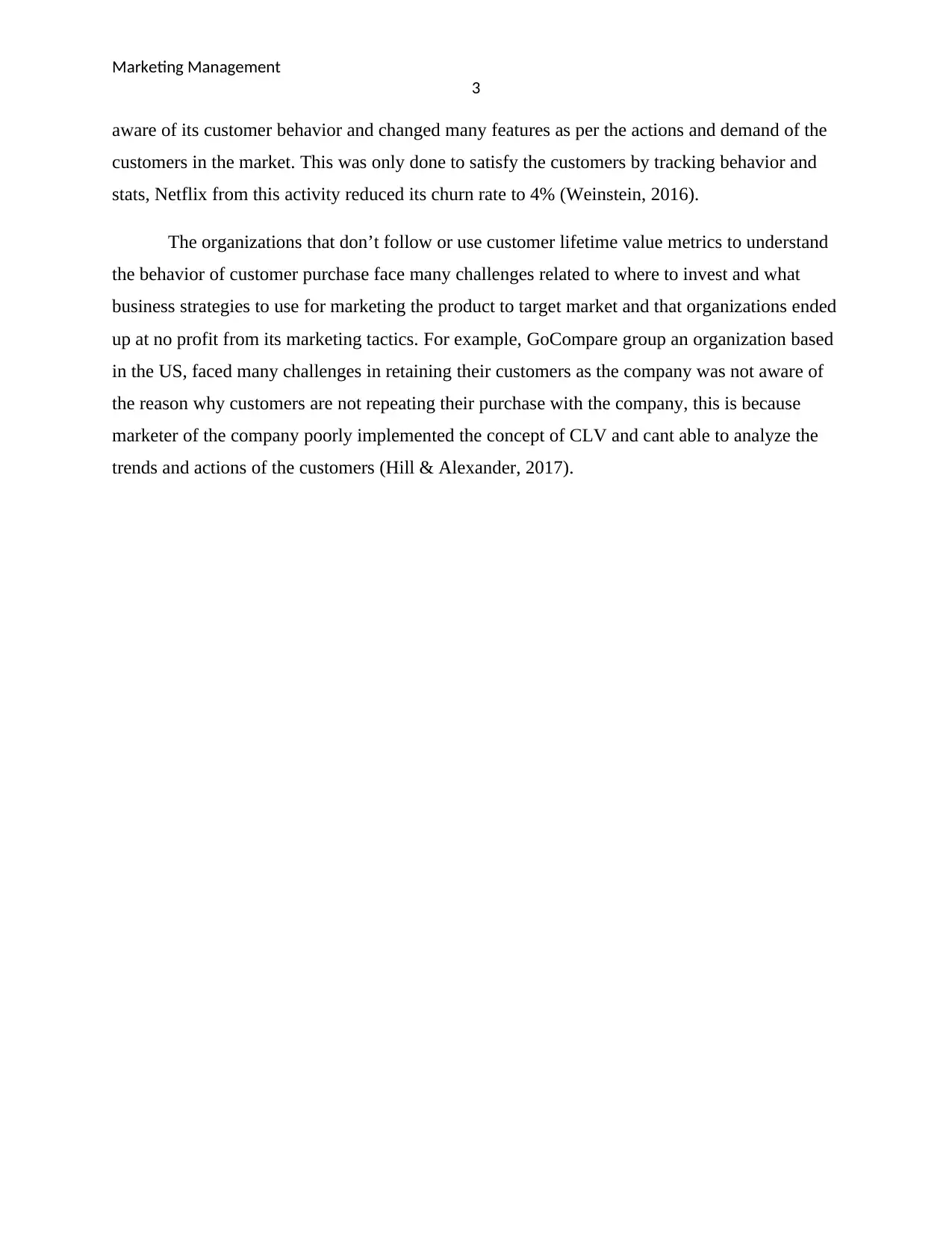
Marketing Management
3
aware of its customer behavior and changed many features as per the actions and demand of the
customers in the market. This was only done to satisfy the customers by tracking behavior and
stats, Netflix from this activity reduced its churn rate to 4% (Weinstein, 2016).
The organizations that don’t follow or use customer lifetime value metrics to understand
the behavior of customer purchase face many challenges related to where to invest and what
business strategies to use for marketing the product to target market and that organizations ended
up at no profit from its marketing tactics. For example, GoCompare group an organization based
in the US, faced many challenges in retaining their customers as the company was not aware of
the reason why customers are not repeating their purchase with the company, this is because
marketer of the company poorly implemented the concept of CLV and cant able to analyze the
trends and actions of the customers (Hill & Alexander, 2017).
3
aware of its customer behavior and changed many features as per the actions and demand of the
customers in the market. This was only done to satisfy the customers by tracking behavior and
stats, Netflix from this activity reduced its churn rate to 4% (Weinstein, 2016).
The organizations that don’t follow or use customer lifetime value metrics to understand
the behavior of customer purchase face many challenges related to where to invest and what
business strategies to use for marketing the product to target market and that organizations ended
up at no profit from its marketing tactics. For example, GoCompare group an organization based
in the US, faced many challenges in retaining their customers as the company was not aware of
the reason why customers are not repeating their purchase with the company, this is because
marketer of the company poorly implemented the concept of CLV and cant able to analyze the
trends and actions of the customers (Hill & Alexander, 2017).
Secure Best Marks with AI Grader
Need help grading? Try our AI Grader for instant feedback on your assignments.
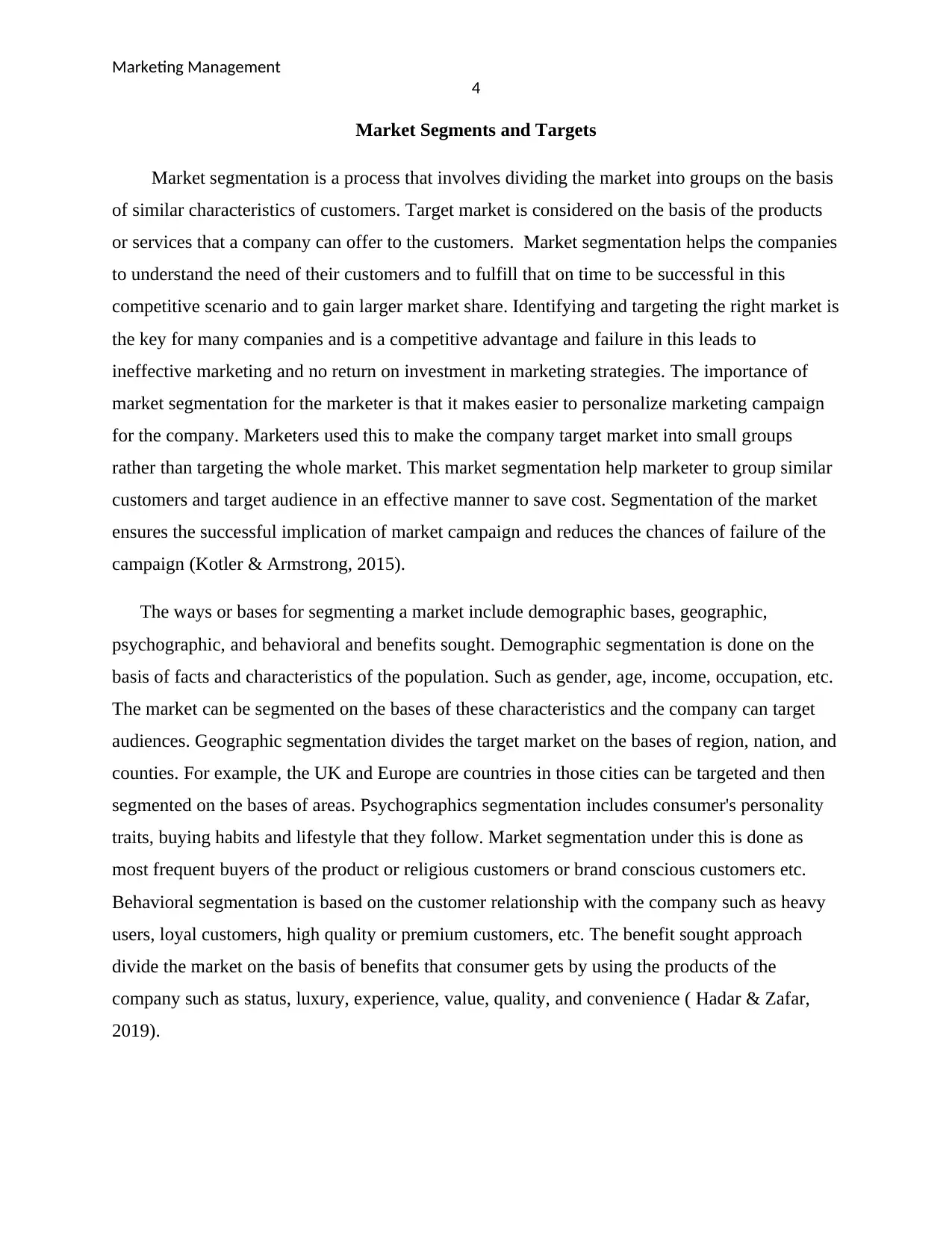
Marketing Management
4
Market Segments and Targets
Market segmentation is a process that involves dividing the market into groups on the basis
of similar characteristics of customers. Target market is considered on the basis of the products
or services that a company can offer to the customers. Market segmentation helps the companies
to understand the need of their customers and to fulfill that on time to be successful in this
competitive scenario and to gain larger market share. Identifying and targeting the right market is
the key for many companies and is a competitive advantage and failure in this leads to
ineffective marketing and no return on investment in marketing strategies. The importance of
market segmentation for the marketer is that it makes easier to personalize marketing campaign
for the company. Marketers used this to make the company target market into small groups
rather than targeting the whole market. This market segmentation help marketer to group similar
customers and target audience in an effective manner to save cost. Segmentation of the market
ensures the successful implication of market campaign and reduces the chances of failure of the
campaign (Kotler & Armstrong, 2015).
The ways or bases for segmenting a market include demographic bases, geographic,
psychographic, and behavioral and benefits sought. Demographic segmentation is done on the
basis of facts and characteristics of the population. Such as gender, age, income, occupation, etc.
The market can be segmented on the bases of these characteristics and the company can target
audiences. Geographic segmentation divides the target market on the bases of region, nation, and
counties. For example, the UK and Europe are countries in those cities can be targeted and then
segmented on the bases of areas. Psychographics segmentation includes consumer's personality
traits, buying habits and lifestyle that they follow. Market segmentation under this is done as
most frequent buyers of the product or religious customers or brand conscious customers etc.
Behavioral segmentation is based on the customer relationship with the company such as heavy
users, loyal customers, high quality or premium customers, etc. The benefit sought approach
divide the market on the basis of benefits that consumer gets by using the products of the
company such as status, luxury, experience, value, quality, and convenience ( Hadar & Zafar,
2019).
4
Market Segments and Targets
Market segmentation is a process that involves dividing the market into groups on the basis
of similar characteristics of customers. Target market is considered on the basis of the products
or services that a company can offer to the customers. Market segmentation helps the companies
to understand the need of their customers and to fulfill that on time to be successful in this
competitive scenario and to gain larger market share. Identifying and targeting the right market is
the key for many companies and is a competitive advantage and failure in this leads to
ineffective marketing and no return on investment in marketing strategies. The importance of
market segmentation for the marketer is that it makes easier to personalize marketing campaign
for the company. Marketers used this to make the company target market into small groups
rather than targeting the whole market. This market segmentation help marketer to group similar
customers and target audience in an effective manner to save cost. Segmentation of the market
ensures the successful implication of market campaign and reduces the chances of failure of the
campaign (Kotler & Armstrong, 2015).
The ways or bases for segmenting a market include demographic bases, geographic,
psychographic, and behavioral and benefits sought. Demographic segmentation is done on the
basis of facts and characteristics of the population. Such as gender, age, income, occupation, etc.
The market can be segmented on the bases of these characteristics and the company can target
audiences. Geographic segmentation divides the target market on the bases of region, nation, and
counties. For example, the UK and Europe are countries in those cities can be targeted and then
segmented on the bases of areas. Psychographics segmentation includes consumer's personality
traits, buying habits and lifestyle that they follow. Market segmentation under this is done as
most frequent buyers of the product or religious customers or brand conscious customers etc.
Behavioral segmentation is based on the customer relationship with the company such as heavy
users, loyal customers, high quality or premium customers, etc. The benefit sought approach
divide the market on the basis of benefits that consumer gets by using the products of the
company such as status, luxury, experience, value, quality, and convenience ( Hadar & Zafar,
2019).
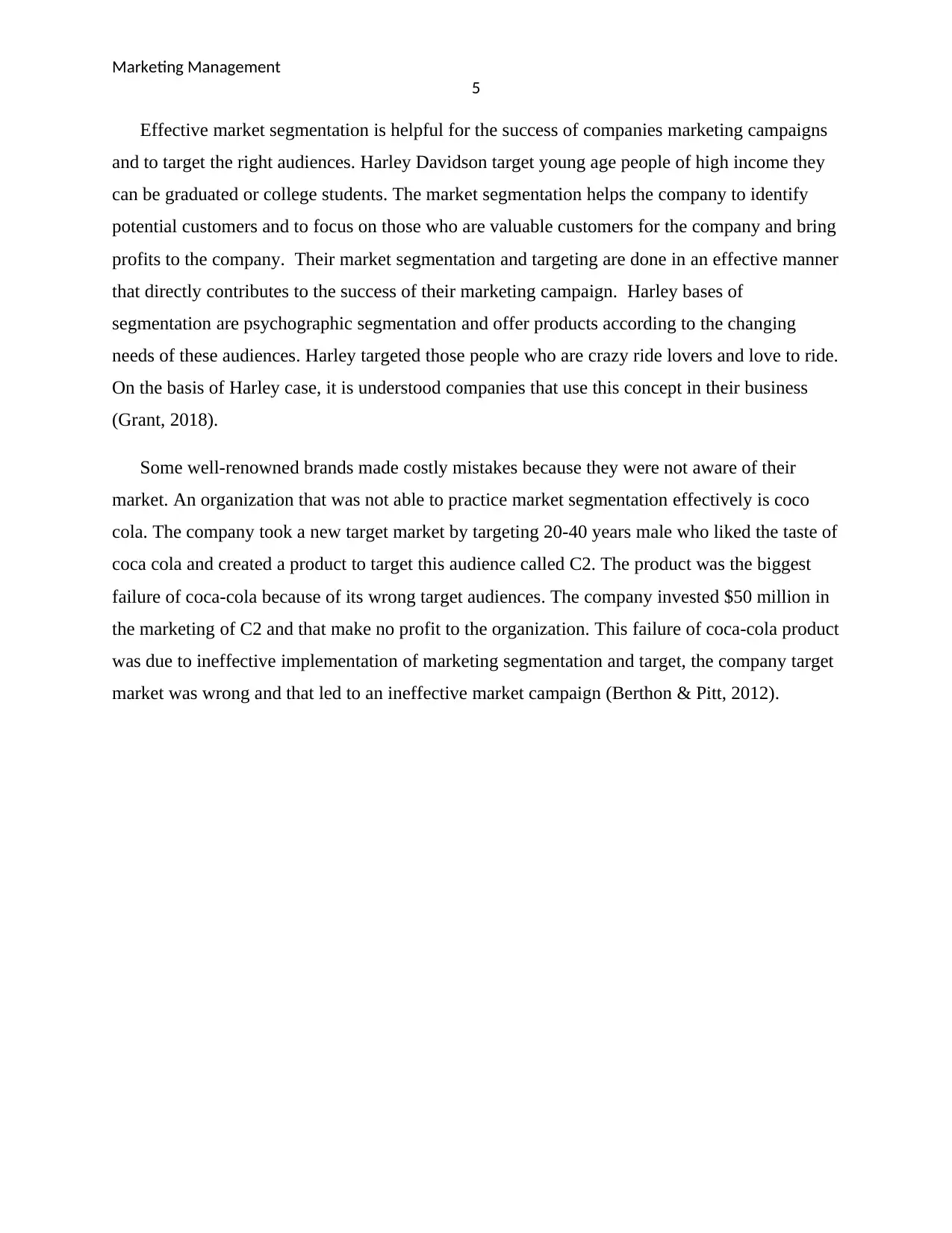
Marketing Management
5
Effective market segmentation is helpful for the success of companies marketing campaigns
and to target the right audiences. Harley Davidson target young age people of high income they
can be graduated or college students. The market segmentation helps the company to identify
potential customers and to focus on those who are valuable customers for the company and bring
profits to the company. Their market segmentation and targeting are done in an effective manner
that directly contributes to the success of their marketing campaign. Harley bases of
segmentation are psychographic segmentation and offer products according to the changing
needs of these audiences. Harley targeted those people who are crazy ride lovers and love to ride.
On the basis of Harley case, it is understood companies that use this concept in their business
(Grant, 2018).
Some well-renowned brands made costly mistakes because they were not aware of their
market. An organization that was not able to practice market segmentation effectively is coco
cola. The company took a new target market by targeting 20-40 years male who liked the taste of
coca cola and created a product to target this audience called C2. The product was the biggest
failure of coca-cola because of its wrong target audiences. The company invested $50 million in
the marketing of C2 and that make no profit to the organization. This failure of coca-cola product
was due to ineffective implementation of marketing segmentation and target, the company target
market was wrong and that led to an ineffective market campaign (Berthon & Pitt, 2012).
5
Effective market segmentation is helpful for the success of companies marketing campaigns
and to target the right audiences. Harley Davidson target young age people of high income they
can be graduated or college students. The market segmentation helps the company to identify
potential customers and to focus on those who are valuable customers for the company and bring
profits to the company. Their market segmentation and targeting are done in an effective manner
that directly contributes to the success of their marketing campaign. Harley bases of
segmentation are psychographic segmentation and offer products according to the changing
needs of these audiences. Harley targeted those people who are crazy ride lovers and love to ride.
On the basis of Harley case, it is understood companies that use this concept in their business
(Grant, 2018).
Some well-renowned brands made costly mistakes because they were not aware of their
market. An organization that was not able to practice market segmentation effectively is coco
cola. The company took a new target market by targeting 20-40 years male who liked the taste of
coca cola and created a product to target this audience called C2. The product was the biggest
failure of coca-cola because of its wrong target audiences. The company invested $50 million in
the marketing of C2 and that make no profit to the organization. This failure of coca-cola product
was due to ineffective implementation of marketing segmentation and target, the company target
market was wrong and that led to an ineffective market campaign (Berthon & Pitt, 2012).
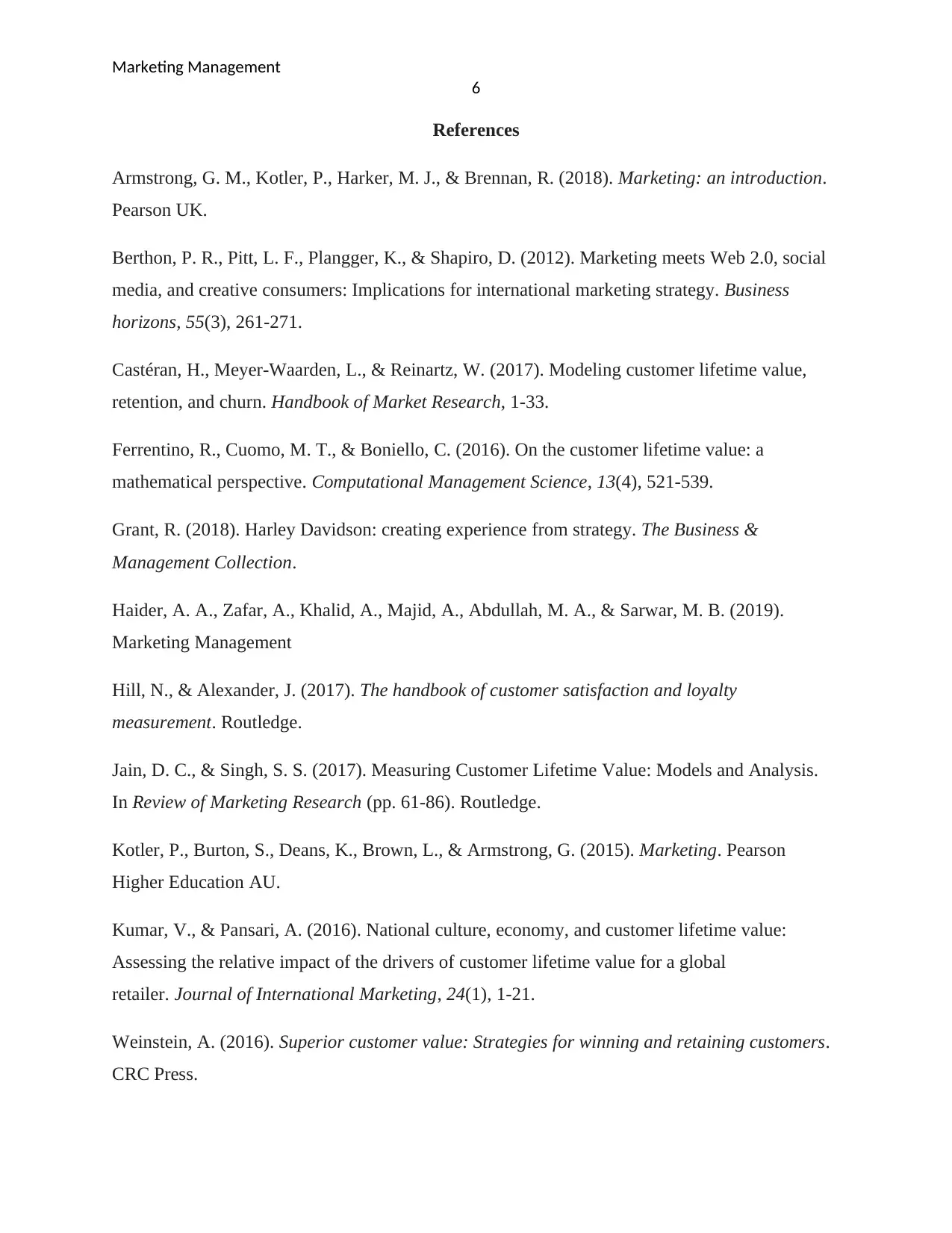
Marketing Management
6
References
Armstrong, G. M., Kotler, P., Harker, M. J., & Brennan, R. (2018). Marketing: an introduction.
Pearson UK.
Berthon, P. R., Pitt, L. F., Plangger, K., & Shapiro, D. (2012). Marketing meets Web 2.0, social
media, and creative consumers: Implications for international marketing strategy. Business
horizons, 55(3), 261-271.
Castéran, H., Meyer-Waarden, L., & Reinartz, W. (2017). Modeling customer lifetime value,
retention, and churn. Handbook of Market Research, 1-33.
Ferrentino, R., Cuomo, M. T., & Boniello, C. (2016). On the customer lifetime value: a
mathematical perspective. Computational Management Science, 13(4), 521-539.
Grant, R. (2018). Harley Davidson: creating experience from strategy. The Business &
Management Collection.
Haider, A. A., Zafar, A., Khalid, A., Majid, A., Abdullah, M. A., & Sarwar, M. B. (2019).
Marketing Management
Hill, N., & Alexander, J. (2017). The handbook of customer satisfaction and loyalty
measurement. Routledge.
Jain, D. C., & Singh, S. S. (2017). Measuring Customer Lifetime Value: Models and Analysis.
In Review of Marketing Research (pp. 61-86). Routledge.
Kotler, P., Burton, S., Deans, K., Brown, L., & Armstrong, G. (2015). Marketing. Pearson
Higher Education AU.
Kumar, V., & Pansari, A. (2016). National culture, economy, and customer lifetime value:
Assessing the relative impact of the drivers of customer lifetime value for a global
retailer. Journal of International Marketing, 24(1), 1-21.
Weinstein, A. (2016). Superior customer value: Strategies for winning and retaining customers.
CRC Press.
6
References
Armstrong, G. M., Kotler, P., Harker, M. J., & Brennan, R. (2018). Marketing: an introduction.
Pearson UK.
Berthon, P. R., Pitt, L. F., Plangger, K., & Shapiro, D. (2012). Marketing meets Web 2.0, social
media, and creative consumers: Implications for international marketing strategy. Business
horizons, 55(3), 261-271.
Castéran, H., Meyer-Waarden, L., & Reinartz, W. (2017). Modeling customer lifetime value,
retention, and churn. Handbook of Market Research, 1-33.
Ferrentino, R., Cuomo, M. T., & Boniello, C. (2016). On the customer lifetime value: a
mathematical perspective. Computational Management Science, 13(4), 521-539.
Grant, R. (2018). Harley Davidson: creating experience from strategy. The Business &
Management Collection.
Haider, A. A., Zafar, A., Khalid, A., Majid, A., Abdullah, M. A., & Sarwar, M. B. (2019).
Marketing Management
Hill, N., & Alexander, J. (2017). The handbook of customer satisfaction and loyalty
measurement. Routledge.
Jain, D. C., & Singh, S. S. (2017). Measuring Customer Lifetime Value: Models and Analysis.
In Review of Marketing Research (pp. 61-86). Routledge.
Kotler, P., Burton, S., Deans, K., Brown, L., & Armstrong, G. (2015). Marketing. Pearson
Higher Education AU.
Kumar, V., & Pansari, A. (2016). National culture, economy, and customer lifetime value:
Assessing the relative impact of the drivers of customer lifetime value for a global
retailer. Journal of International Marketing, 24(1), 1-21.
Weinstein, A. (2016). Superior customer value: Strategies for winning and retaining customers.
CRC Press.
Paraphrase This Document
Need a fresh take? Get an instant paraphrase of this document with our AI Paraphraser

Marketing Management
7
7
1 out of 8
Related Documents
Your All-in-One AI-Powered Toolkit for Academic Success.
+13062052269
info@desklib.com
Available 24*7 on WhatsApp / Email
![[object Object]](/_next/static/media/star-bottom.7253800d.svg)
Unlock your academic potential
© 2024 | Zucol Services PVT LTD | All rights reserved.





